‘I’m Going to UCSB!’
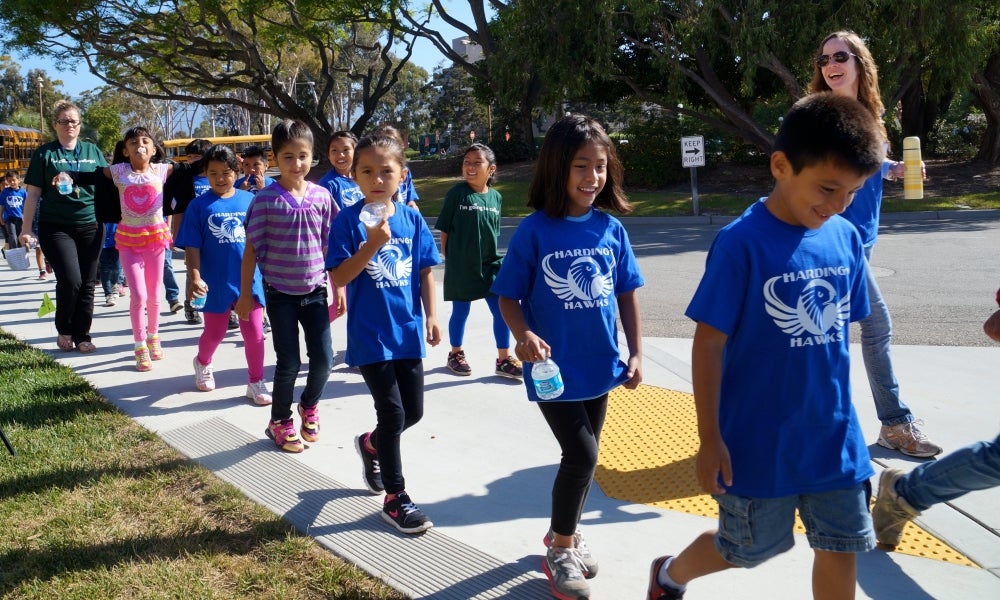
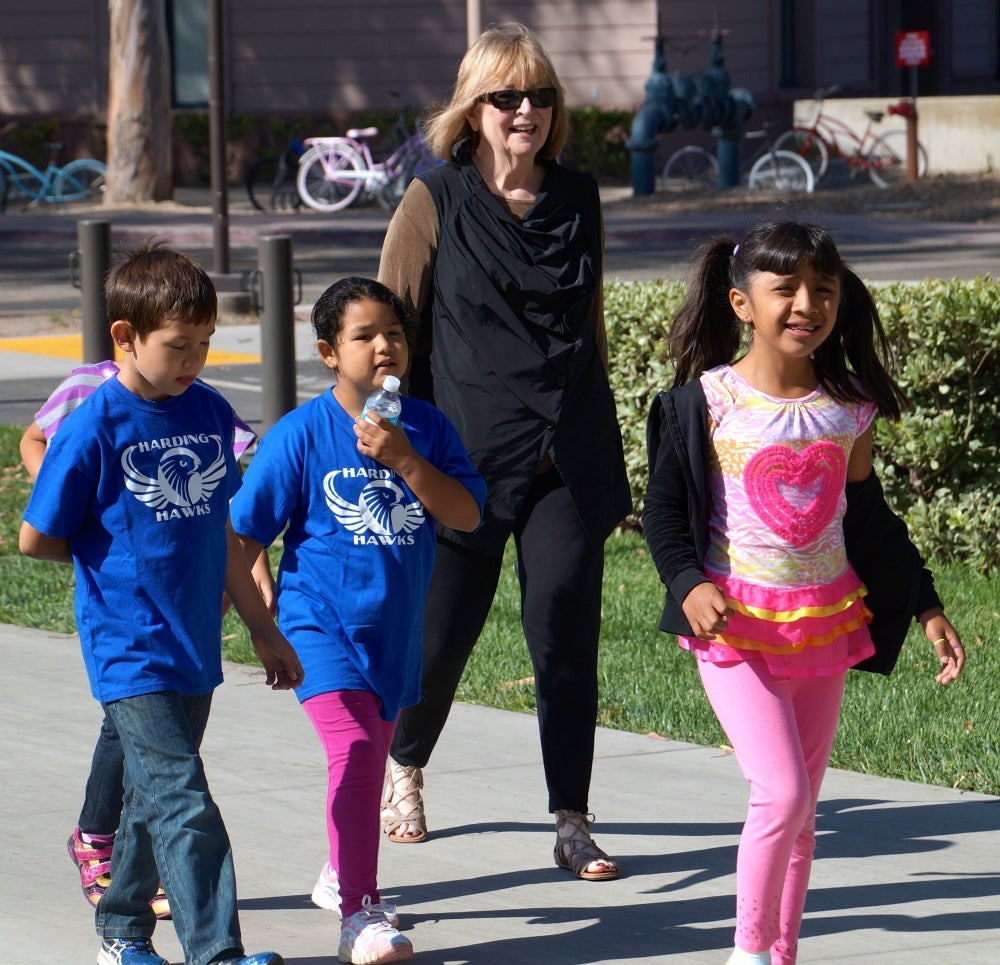
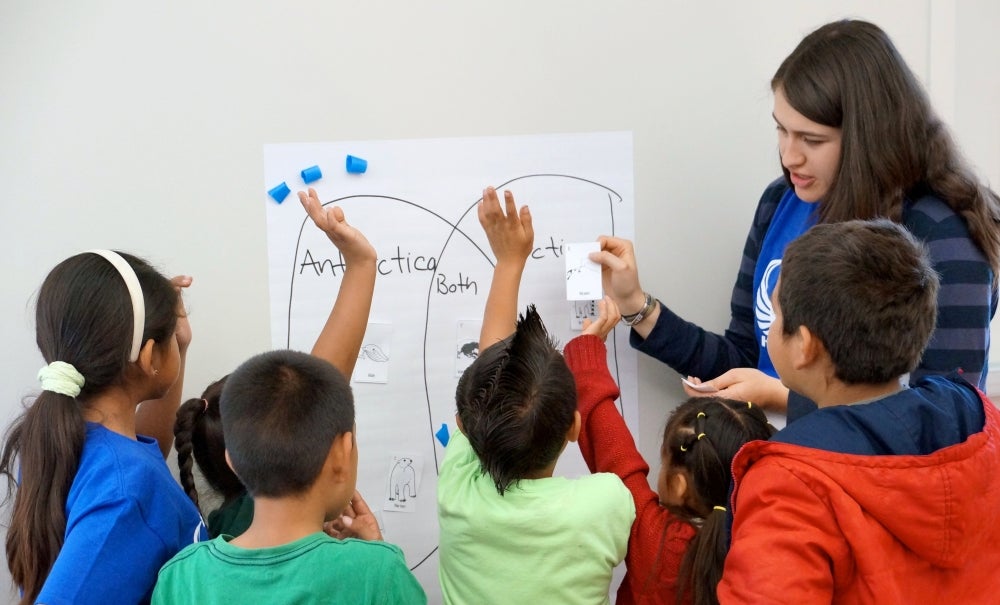
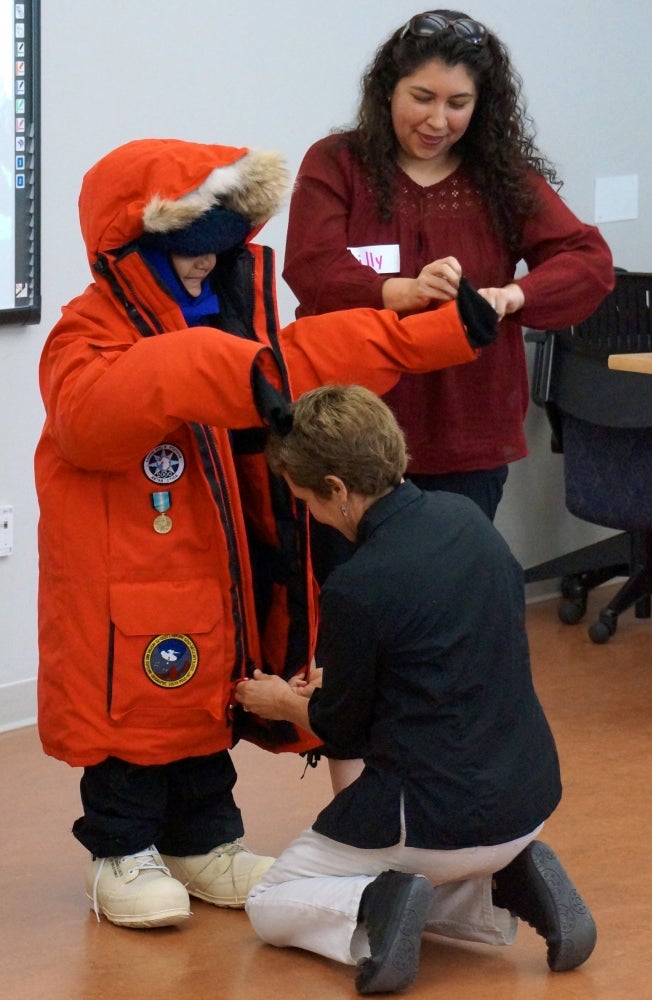
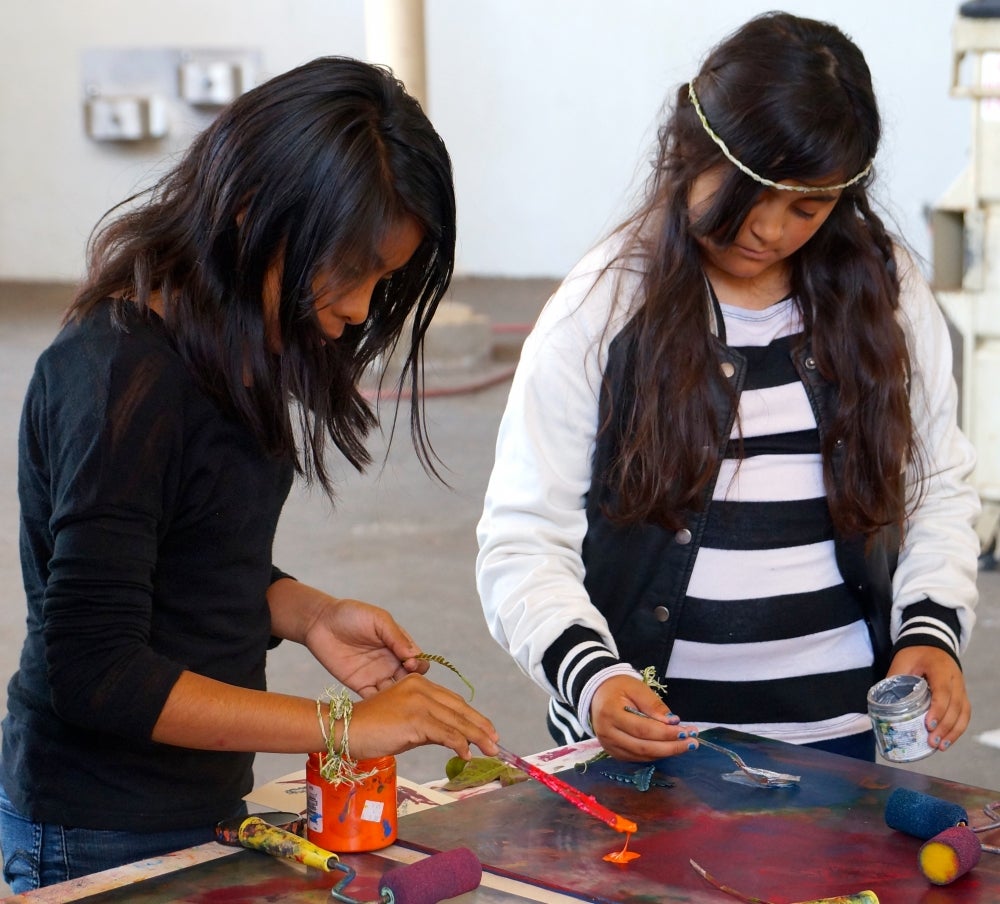

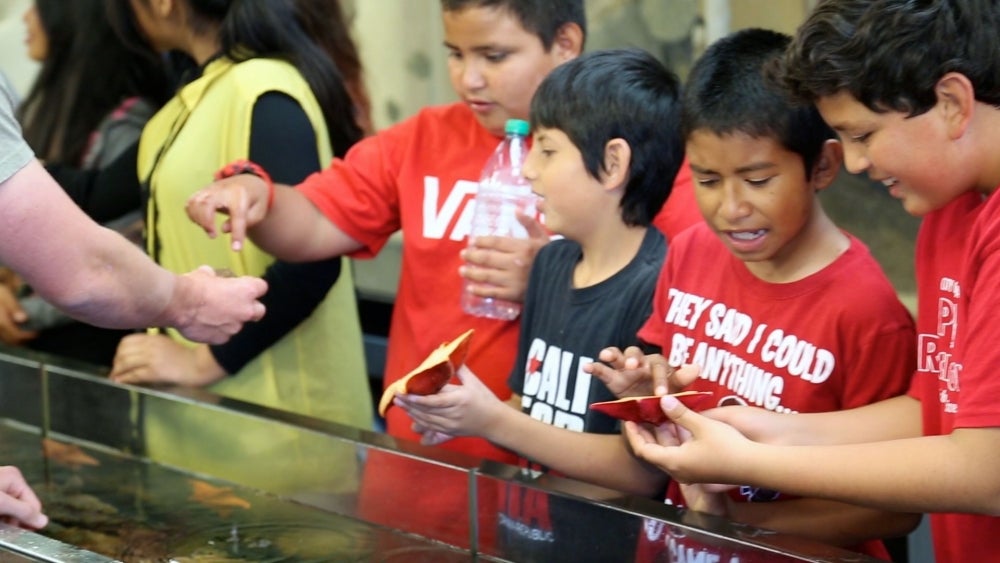
It’s not often — or ever — that a group of first-graders goes to Antarctica. But some young students from Santa Barbara recently got a good look at the South Pole, by way of UC Santa Barbara’s Gevirtz Graduate School of Education (GGSE).
It was all part of a virtual trek facilitated by the GGSE and the students’ home campus, Harding University Partnership School, during UCSB Day, an annual event that brings the whole of Harding’s student body — pre-kindergarteners through sixth-graders — to the university for a morning of fun, games and scholarly inquiry.
UCSB Day, which took place on May 14, has become a highlight of the school year since Harding and Gevirtz joined forces in 2010 and entered into an academic marriage that appears to have happily ever after written all over it.
Once on the precipice of being taken over by an outside agency, or completely restructured, after years of underperforming on state-mandated assessments, the elementary school has seen test scores soar since being reborn as Harding University Partnership School. UCSB, meanwhile, has gained opportunities and a fertile training ground for undergraduate and graduate students alike, who mentor, tutor and student-teach at Harding.
It’s the type of innovative collaboration that’s become a hallmark of UCSB culture — and one that has exacted a culture change on the formerly failing elementary school. As of fall 2012, Harding achieved the status of International Baccalaureate Programme, making it the only Santa Barbara elementary school — and one of just a few grade schools across the country — using the highly acclaimed approach to education that emphasizes critical thinking, interdisciplinary skills and a global perspective.
“There are other examples of university so-called ‘lab schools,’ but usually it’s a university establishing a rather elite school for their professors and students,” said Gevirtz Dean Jane Close Conoley. “This is one of very few where we went in with an equal partnership with a regular public school.”
And the results have been astounding. Not only in terms of test scores, which have shot up since the partnership began, but also in the academic development of the Harding students. “The change in these children across the years has been dramatic,” said Conoley. “Once a week I mentor two sixth-graders who are creating their final project, and they’re talking to me about central ideas and lines of inquiry.”
At the time the partnership began, most of the Harding students had never been to UCSB, even though the campuses are no more than 10 miles apart. Nor had their parents. “So the main goal is to make them comfortable about seeing themselves on a college campus,” Conoley said.
One look at the smiles and enthusiasm among the students, from pre-kindergarteners in Robertson Gym to fourth graders in the Materials Research Lab to sixth-graders at the Research Experience & Education Facility (REEF), proves the UCSB-Harding collaboration is on the right track. According to Harding Principal Vanesha Davis, the partnership — and the annual visit to UCSB — lends her students a sense of possibility and optimism.
“This means a lot to our kids,” Davis said. “It gives them a firsthand experience of what college life is like. Being that they get to come here and see and interact and learn, I think gives them a greater understanding and gives them a picture of a future for themselves. I think that’s huge.
“They tell me all the time, ‘Ms. Davis, I’m going to go to UCSB,’” she added. “I say, ‘You go!’”
The Nature of Things
“We’re going to Antarctica today — in our minds,” researcher Peggy Lubchenco told a group of first-graders before launching into a tutorial on the continent’s climate, ecology and biodiversity. As part of the lesson, she recruited Leslie, a more-than-willing participant, to serve as an impromptu model for the clothing required to survive the arctic temperatures. The polypropylene long johns came first, followed by wool socks, wind pants, two layers of gloves, face mask, wool hat, gigantic “bunny boots” and a massive parka Lubchenco dubbed “Big Red” and described as “a walking sleeping bag.”
And then, of course, there were the goggles, which left Leslie’s face obscured, save her nose. Her laughter, though, was clearly audible as her classmates gave her a round of applause.
While the first-graders learned about penguins, blue whales and fur seals, the second-graders embarked on a cross-campus treasure hunt exploring landmarks, including the Campus Lagoon, Storke Tower and the carillon bells, the University Center and residence halls, among other places. The third-graders meanwhile were engaged in science experiments to study the particles in solids, liquids and gases.
At the Cheadle Center for Biodiversity and Ecological Restoration, some lucky — and brave — fifth-graders took turns holding snakes and perusing the center’s impressive collection of preserved specimens (birds, bats, a seal, and, again, snakes). They also got a chance to get creative, learning about plant and flower morphology, and local flora and fauna, while making art from branches, flowers and leaves.
Living in a Materials World
On the other side of campus, many of Harding teacher Verity Allen’s fifth-graders had their aspirations emblazoned across their chests by way of T-shirts that read “I’m Going to College.” They had gathered at UCSB’s Materials Research Laboratory (MRL) to learn about how scientists develop new materials for a host of applications from underwater adhesion to blood coagulation to robotics, and how they draw their ideas from nature.
The elephant, whose trunk is made up of 40,000 muscles, was the inspiration for the eagle claw toes the children constructed from plastic tubing (notched so it would bend), straws through which a section of string was threaded, and a paper clip.
They also studied the tensile strength of thread made from four different materials — Kevlar, nylon, cotton and steel — by counting the number of one-pound water bottles each could support before breaking. To the students’ surprise, Kevlar proved stronger than steel.
“This is such a benefit in so many ways,” Allen said of the UCSB Day experience. “For my kids, the hands-on experience is awesome. They love doing hands-on science. And it’s great for them to see the UCSB students and the volunteers. For some of the kids in my class, their parents didn’t go to college, and this gets them excited.”
“These are simple experiments that can encourage scientific inquiry even for the youngest students,” said Frank Kinnaman, the education program coordinator for the MRL. “And they really seem to enjoy them.” Having the students come to campus rather than take the experiments to them provides an additional — and, perhaps, more significant — benefit to the students. “They’re able to see the surroundings where they can someday study themselves,” Kinnaman noted.
Under the Sea
“What do you do with old chemists when they die?” Scott Simon asked a group of sixth-graders lying supine on the grass near UCSB’s Marine Science Building. “You barium,” he said. “Barium — it’s a chemical element. You’ll understand it when you go to college.”
Simon, the educational program manager for the Marine Science Institute, used his time with the Harding students to give a lesson on, among other things, the concept of survival of the fittest and the qualities that determine fitness.
Fitness, he explained, depends on the situation. “It doesn’t mean you’re fast or smart or strong,” he said. “It can, but it doesn’t have to. It means you’re going to have the resources or are better adapted for a given situation and you will survive and reproduce and pass your genes along.” His point was proven when the children were directed to find and retrieve sections of garden hose that had been strewn across a nearby hill.
Following Simon’s discussion on the theory of natural selection, the children split into two groups with one visiting the touch tanks (becoming acquainted with a California eel, sea stars and a juvenile swellshark, among others, and the other checking out the tidal pools at Campus Point. In each place, the students learned about what made one marine creature fitter than another and how a characteristic that worked well for one might not be as beneficial to another.



